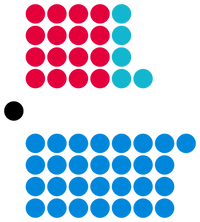House of Commons: Difference between revisions
Jump to navigation
Jump to search
No edit summary |
No edit summary |
||
| Line 38: | Line 38: | ||
|election6 = 17 April 2023 | |election6 = 17 April 2023 | ||
|leader7_type = [[Shadow Leader of the House of Commons|Shadow Leader of the House]] | |leader7_type = [[Shadow Leader of the House of Commons|Shadow Leader of the House]] | ||
|leader7 = [[Lenauro1972]] | |||
|party7 = [[Labour]] | |||
|election7 = 29 April 2023 | |||
|members = 50 | |members = 50 | ||
|structure1 = March2023Composition.png | |structure1 = March2023Composition.png | ||
Revision as of 14:56, 2 May 2023
The Honourable the Commons of the United Kingdom of Great Britain and Northern Ireland in Parliament assembled | |
|---|---|
| 72nd Parliament | |
 Logo used to represent the House of Commons | |
 Flag of the House of Commons | |
| Type | |
| Type | Lower house of the Parliament of the United Kingdom |
| Leadership | |
JamesAcheson since 21 April 2023 | |
| Structure | |
| Seats | 50 |
 | |
Political groups |
|
Length of term | Up to 2 months |
| Elections | |
Voting system | Webster/Sainte-Laguë |
Last election | 12 March 2023 |
Next election | No later than 13 May 2023 |
The House of Commons is the lower house of Parliament. Like the upper house, the House of Lords, it meets in the Palace of Westminster. The House of Commons is an elected body consisting of 50 members known as Members of Parliament (MPs). In elections, citizens vote for a party, seats are allocated using the Webster/Sainte-Laguë method, and parties appoint people to the seats they've won.